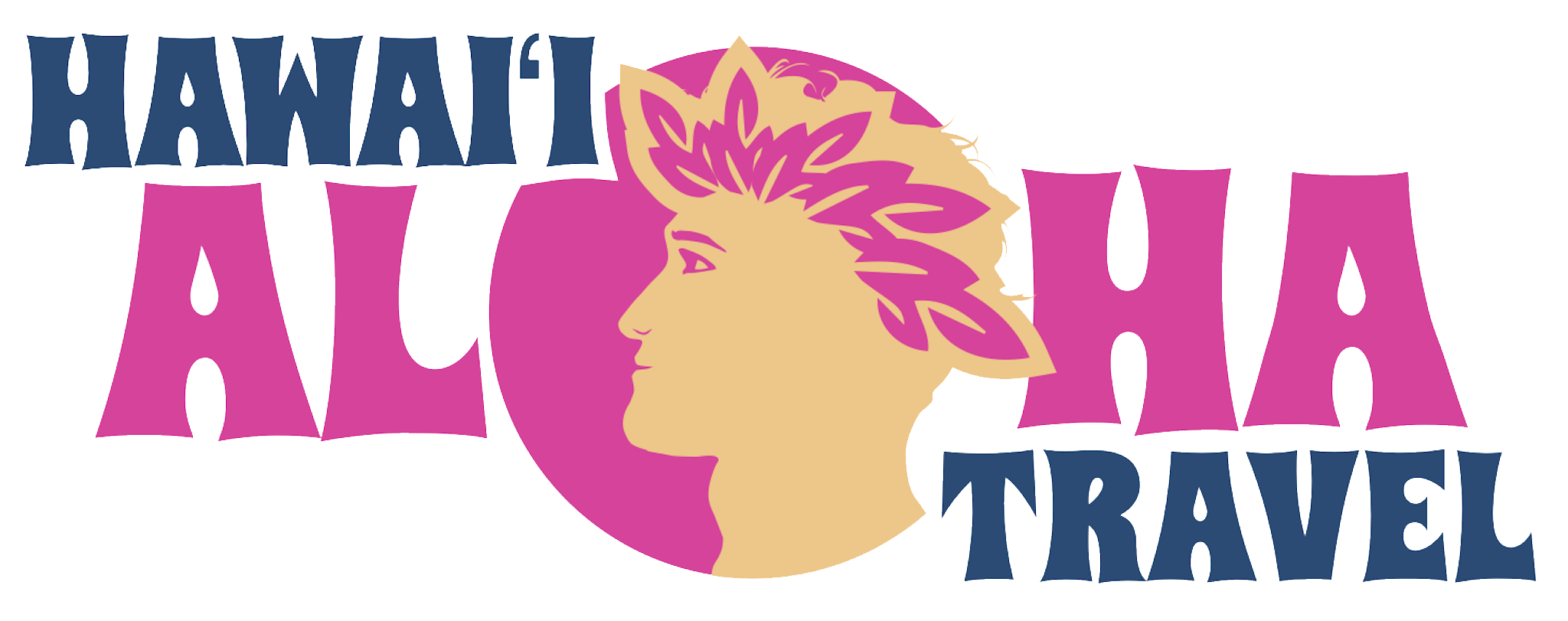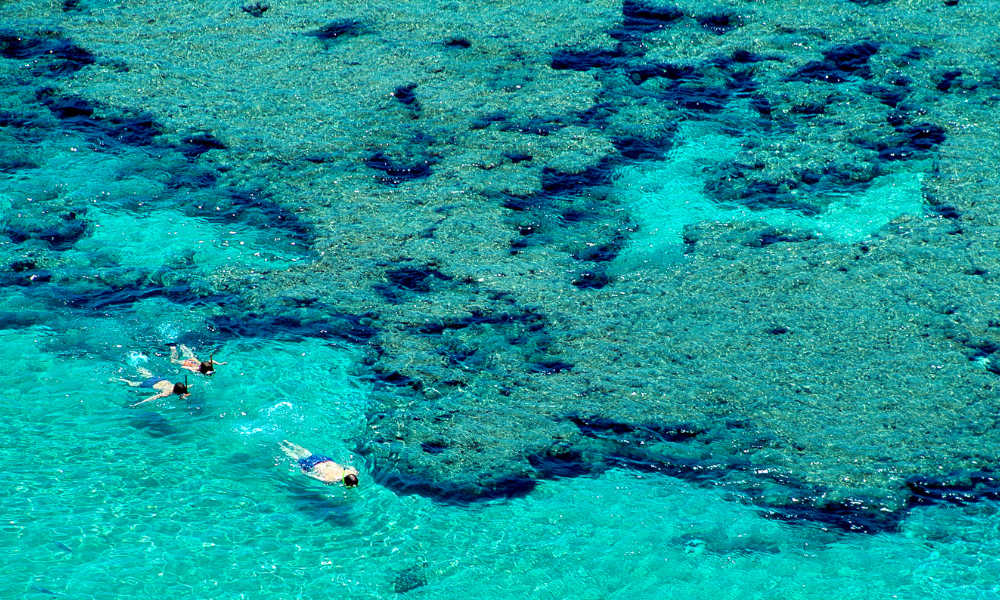Snorkeling in Hawaii is one of the best beach activities for travelers and locals alike. It’s an incredible way to experience the warm ocean and underwater life. And one wants to miss out on that!
Many visitors will snorkel every day of their Hawaii vacation – a great activity since it’s free in most spots. But even if you only snorkel once or twice while you’re here, you’re in for a great adventure.
We receive a lot of questions about snorkeling in Hawaii, particularly for beginners. Visitors will ask where the best spots are, what the gear is like, how to rent it, and the basics of snorkeling. Today, we’ll cover these questions and more, including two of the very best snorkel locations on the four main islands of Oahu, Kauai, Maui, and Hawaii Island.
Learn the basics of snorkeling so you can be ready for the water when you arrive. And for those of you already experienced, you might learn something new from the tips and recommendations we have for you today. With snorkeling being such a popular and truly fun Hawaii activity, we highly suggest you take advantage of the tropical waters and explore the unique underwater life of the Pacific.
Hawaii Snorkeling Gear
Let’s start with the essentials: snorkel gear. For maximum comfort and safety, you’ll want a mask, snorkel, and fins.
The snorkel is what you breathe out of and is attached to the mask, while the fins are slipped on your feet to allow quicker and more fluid kicking motion underwater.
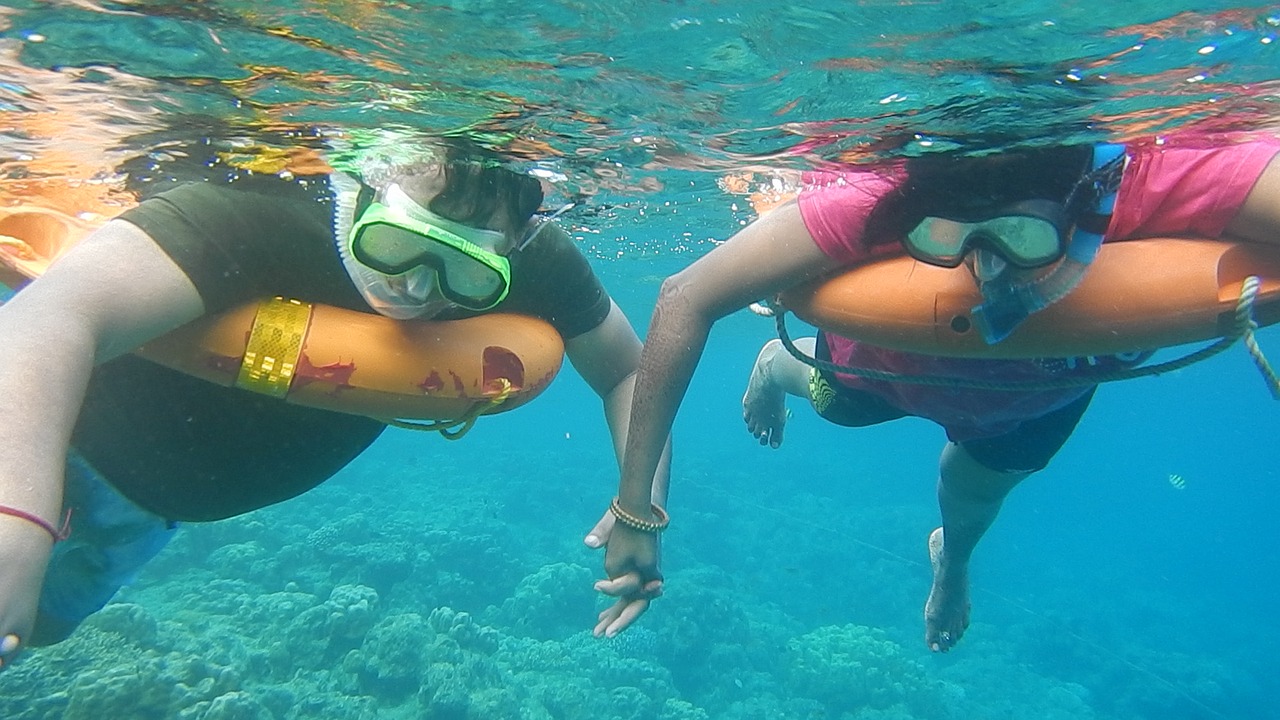
Rent Vs. Buy
You can rent gear in Hawaii for anywhere between $5-$20 a day. Snorkel gear rentals are easy to find. Activity huts or shops are usually near most popular snorkel locations. The people renting out the gear are typically friendly and helpful and will brief you on the equipment and how to use it properly.
But if you plan to do a lot of snorkeling, you might just want to invest in your own gear. You can purchase a decent mask and snorkel set at the local grocery or convenience store for $10-$20, which might be the more cost-efficient way for you and your family to snorkel.
And if it’s too expensive, go without the fins. They’re not super necessary for beginner snorkeling, and if it saves you money, then it might be worth it. If you snorkel without fins or reef shoes, be careful of your footing when getting in and out of the water. Sea urchins (a.k.a. wana) are known to lurk in the nooks and crannies of reefy areas.
Sun Protection
Sunburn is the most common snorkeling peril. In the refreshing water, you may not feel the sun’s intense rays scorching your neck, shoulder, back, and legs.
You’ll want to apply reef-safe sunscreen thoroughly, and take breaks to reapply based on the package instructions.
Many snorkelers will also wear a rash guard or full suit to protect themselves from the sun.
Other Equipment
Snorkeling in Hawaii is a simple activity that doesn’t require lots of large equipment. Still, you may want some items to make your adventure even easier or more fun. A swim noodle will help keep you afloat as you snorkel, and an underwater camera can make sure you get proof of your sea turtle spotting.
What to Expect Snorkeling in Hawaii
Snorkeling is one of the best ways to see Hawaii’s marine life. As you meander through calm waters, you may see green sea turtles, colorful reef fish, manta rays, and the Humuhumunukunukuapua’a, which is Hawaii’s state fish.
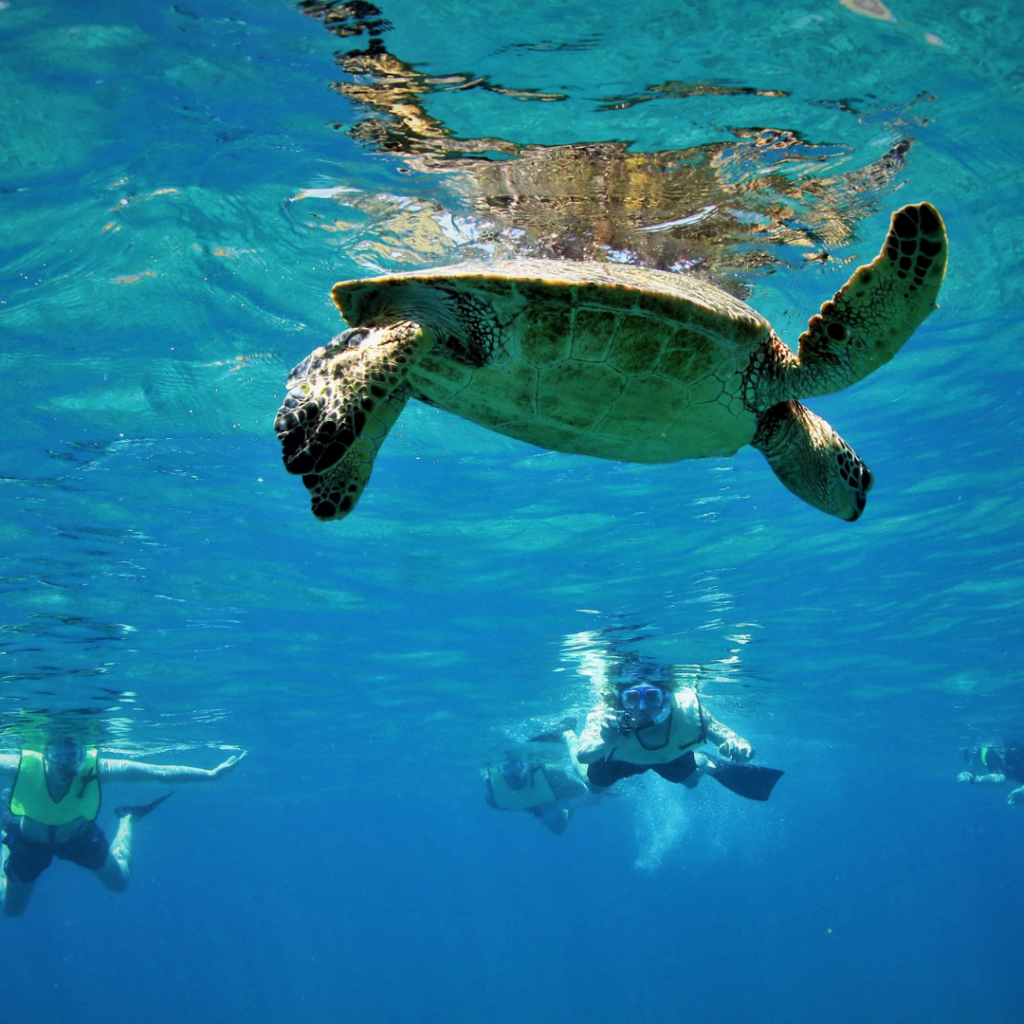
Is Snorkeling in Hawaii Easy?
Snorkeling is typically an easy activity that most skill levels can enjoy.
The snorkel takes the most time getting used to, as many people aren’t comfortable having their nose restricted by the mask and breathing out of just their mouth.
But after a few strokes in the water with your face down, you should be just fine. Stay calm and try to slow your breathing down. That will help you get used to the snorkel.
Learning to Snorkel
If you’re nervous about snorkeling in the open ocean, try getting familiar with the process in the hotel pool first. You likely won’t need a guided lesson, just some practice swimming with your mask and snorkel.
Once you are comfortable with the gear, the ocean experience will be much easier and more fun.
Ocean Safety
Even the most popular snorkel spots can be dangerous. Ocean conditions can change quickly, and rip currents can turn a relaxing snorkel into a disaster.
Our top recommendation is to snorkel only on beaches with lifeguards or on official snorkel boat tours. Always check in with lifeguards before entering the ocean. They can let you know where to swim for the best safety (and best sea life spotting!).
And look up often as you snorkel to stay aware of your location.
This is a great resource for learning about rip currents in Hawaii.
Top Snorkeling Destinations in Hawaii
Now that you know all about the gear you need and how to prepare for snorkeling in Hawaii, you’re ready to hit the ocean. Ahead are some of our top spots to enjoy Hawaii’s natural underwater beauty.
Oahu
Hanauma Bay: Our first snorkeling recommendation on Oahu is Hanauma Bay near the east end of Waikiki. This place is incredibly popular, so the state now charges an entry fee for non-residents to access it. Anyone over 12 years old will need to pay a $25 fee. Children, residents, and active military are free.
Make a reservation online two days in advance, or show up before 6:45 AM for a chance to get one of the few same-day passes.
It’s a big effort, but it may be worthwhile to access one of the best places for snorkeling in Hawaii.
There is a short video before you hit the beach that is mandatory for all visitors. It informs guests of proper snorkeling protocol, which includes not standing on the reef or harassing the wildlife. The video is a good way to learn about the fragility of the reef ecosystems so that you can be aware throughout your stay in Hawaii.
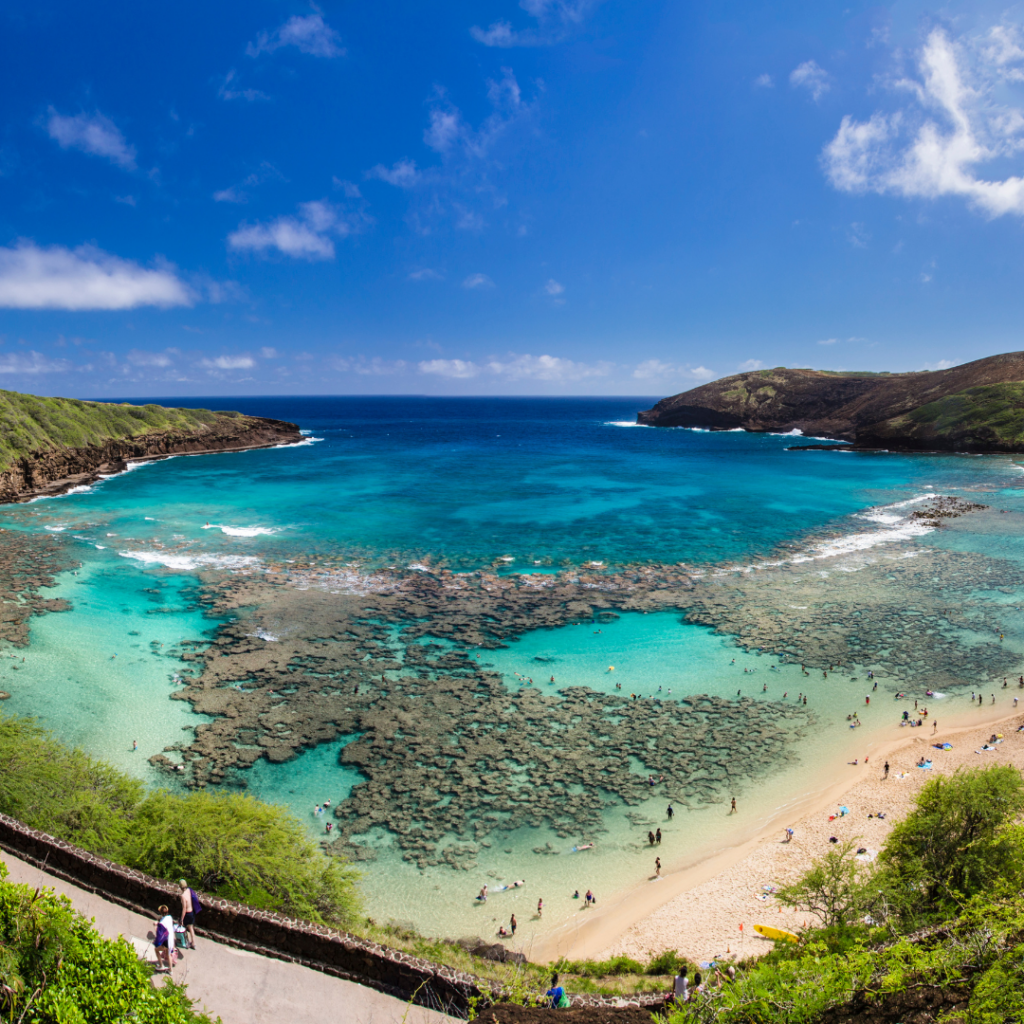
Shark’s Cove: Our second favorite Oahu Snorkeling location is Shark’s Cove on the North Shore. Many visitors mistake the shallow, rocky pool next door just beyond the beach as Shark’s Cove, but it’s actually the deeper blue pool of water that is protected by two points in the reef. Here you’ll see a variety of fish, from humuhumunukunukuapuaa to angelfish to schools of triggerfish and stick fish. Plus, turtle and manta ray sightings are common.
There is a snorkel gear rental shop directly across the street from Shark’s Cove, as well as a local grocery store (Foodland) that sells masks and snorkel sets.
Kauai
Poipu Beach: The number one snorkel recommendation on the south side of Kauai is Poipu Beach. Here you can snorkel the reefy underwater world and spot turtles, fish, and eels. Then enjoy a gorgeous beach park afterward.
There is also a neighboring beach called Waiohai that is good for snorkeling, just make sure you don’t get in the way of any surfers! Poipu Beach is fun, safe, and a great introductory Hawaii snorkel spot for beginners. It’s also ideal for a family beach day since it has showers, restrooms, pavilions, picnic tables, and lifeguards.
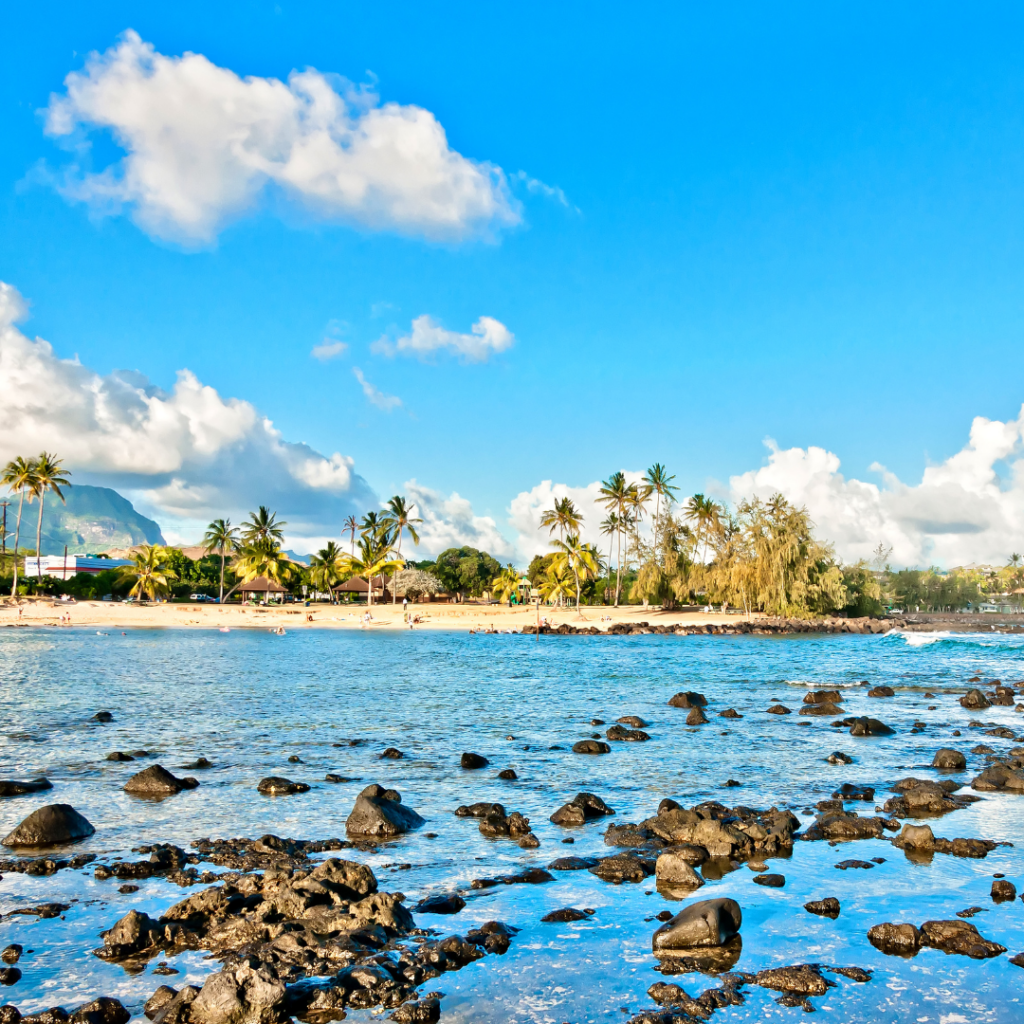
Ke’e Beach: Ke’e Beach is our second snorkeling recommendation. It’s located on Kauai’s north shore. The parking lot can become congested, but the underwater adventure is definitely worth your time.
Ke’e is great for beginners because there is a shallow pool of water with a sandy bottom to help you become comfortable with your gear. You’ll also see schools of fish pass by in this saltwater pool, which is fun for kids.
Just beyond the sandy bottom bay is the unique reef, with crevices, caves, and arches to explore. Abundant with fish, Ke’e has clear waters and a beautiful backdrop of the Na Pali coast. Ke’e Beach is also the starting point of the Hanakāpīʻai trail, which courses along the famed Na Pali coast and up to a breathtaking waterfall.
Ke’e Beach is part of Hāʻena State Park, which requires reservations and entry fees to visit. You can reserve your spot here up to 30 days in advance.
Maui
Kaanapali Beach: Along Maui’s west coast, you’ll find the white sands and turquoise waters of Kaanapali Beach. At the west end of this beach is Black Rock, where snorkeling is best. There is a gradual slope from the shore into the water, which is an excellent introduction for beginner snorkeling in Hawaii.
Like most sandy bottom swimming areas, you’ll spot a few schools of fish here and there, but it’s along the reef where the real underwater life comes alive. This is why we recommend snorkeling along Black Rock.
Adventure seekers even climb up Black Rock and jump into the clear waters below.
Kapalua Bay: Kapalua Bay is our next snorkeling choice on Maui. The calm and protected waters make it perfect for families and beginners.
A c-shaped cove, Kapalua Bay begins with a sandy bottom and then levels off into the reef. The further north you swim, the clearer the water becomes, so you might want to set your towel down on the northern point of the bay for ultimate underwater visibility.
With public showers, restrooms, and a parking lot, Kapalua Bay is a great place to spend the entire day relaxing at the beach. And the fish varieties you’ll see will amaze you!
Hawaii Island (Big Island)
Kahaluu Beach: On the Big Island, we like to recommend Kahaluu Beach Park, which is right in the town of Kailua Kona. This small sheltered cove is great for beginners because it’s not overwhelming and it is very contained. Just about neck deep, Kahaluu barely gets deeper than 10 feet, even during high tide. With such shallow and calm waters and friendly fish, Kahaluu is perfect for the first-time snorkeler.
Mauna Kea Bay: Our last snorkel spot recommendation is Mauna Kea, otherwise known as Kauna’oa Bay. This spot for snorkeling in Hawaii is uncrowded, expansive, and incredibly picturesque. For the best snorkeling experience, be sure to enter the water at one of the rocky points on either end of the beach (Although the north/right side of the beach is better for snorkeling and water visibility).
Since ocean life congregates around the coral and the rocky reefs, you’ll see a variety of tropical fish here, and then enjoy the white sand after a good snorkel.
Parking is just over $20 at Mauna Kea Beach Resort. Arrive early, as there is limited parking available.
Snorkeling: One of Hawaii’s Best Activities
Snorkeling is such a fun adventure, and it can provide hours, if not days, of entertainment for families, couples, travelers, and locals.
There are many snorkel spots all over Hawaii that all provide their own unique and unforgettable experiences. Just like each island, no two are exactly alike. That’s why we encourage you to explore as much of the islands as you can!
